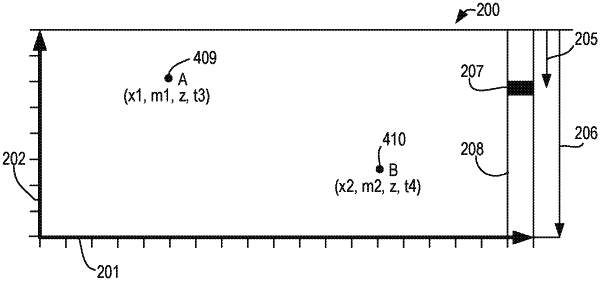| CPC G06F 3/0485 (2013.01) [G06F 3/03543 (2013.01); G06F 3/0487 (2013.01); G06N 5/04 (2013.01); G06N 20/00 (2019.01)] | 14 Claims |

|
1. A method comprising:
receiving information from an input pointing device;
obtaining a first coordinate from the information with respect to a first direction of a display;
obtaining a second coordinate from the information with respect to a second direction of the display;
obtaining a third coordinate from a scrolling value representative of a ratio of scrolling distance in a vertical direction of a contiguous presentation of displayable information for display to a scroll range of the contiguous presentation of displayable information within the display, wherein the scrolling distance is from top of a scroll bar trough to a location of a scroll bar thumb, wherein the scroll bar spans the scroll range;
obtaining a fourth coordinate representative of a time at which a cursor of the input pointing device is currently placed at the first coordinate and the second coordinate are obtained;
providing a location of a user's navigation of the contiguous presentation of displayable information, wherein the location is represented by a pixel having coordinates including the first coordinate, the second coordinate, the third coordinate, and the fourth coordinate, wherein no two or more different locations within the contiguous presentation of displayable information have an identical combination of values of the first coordinate, the second coordinate, the third coordinate, and the fourth coordinate, and wherein locations within a display screen area have the same third coordinate;
obtaining a wireframe representation for the contiguous presentation of displayable information;
reconstructing the user's navigation of the contiguous presentation of displayable information based on the wireframe representation and the first coordinate, the second coordinate, the third coordinate, and the fourth coordinate;
obtaining historical navigation data for the contiguous presentation of displayable information; and
predicting user intent based on the wireframe representation, the first coordinate, the second coordinate, the third coordinate, the fourth coordinate, and the historical navigation data.
|